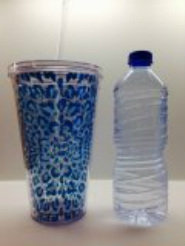
**Pictured: BPA free drinking cup along with disposable plastic water bottle.
BPA is a chemical in plastics. It is in plastic bottles, dental sealants, medical devices, lining of canned goods, etc. Most of us, 90% have BPA present in our bodies. This is primarily due to consumption of food that has been in containers made with BPA. It is considered an environmental estrogen because it acts like estrogen in the body. In the body it can cause estrogen levels to rise and change the internal hormonal balance which may trigger a migraine as well as cause other problems.
I do know that fluctuations in estrogen levels is a trigger for most people with migraines. I don't think plastic is the main reason for my migraines, however, I consider it a potential trigger. Back when I started my migraine plan, I started eating mostly real foods, no packaged foods, very rarely a canned item (green chilies is the only item I can think of that I consume from a can). So, it may be possible that I inadvertently eliminated most of my BPA exposure when I changed my diet. When I am at home I usually drink from a glass or mug, not plastic cups and I am not a huge consumer of plastic bottles. That being said when I am in an airport I always buy a plastic water bottle (maybe I should start supplying my own drinking container when traveling).
I guess migraines aren't the only problem associated with BPA. The FDA used to say BPA was safe, but changed their statement in 2010 stating that studies show "current levels" of human exposure are safe. They have also expressed concern over the potential effects on the brain, behavior, prostate glands in fetuses, and young children. Here is a list of potential problems according to WebMD:
1. Hormone Disruption
2. Brain and behavior effects
3. Cancer
4. Heart problems
5. Possible connection to "obesity, diabetes, ADHD, and others."
6. Possible risk to developing bodies of infants and young children.
When I started my Migraine Plan a year and a half ago, I eliminated a lot of BPA simply as a result of preparing all of my own food. I started eating a lot more whole and organic produce and meats and a lot less packaged and canned foods. It looks like data shows more than one reason to reduce BPA exposure. Here's my plan to do that:
1. I will make sure plastics I am using are BPA free. Get rid of plastics with the number 3 and 7 on the bottom, which are more likely to contain BPA.
2. I will use non-plastic or BPA free food containers and bottles for drinking and food storage.
3. I will not ever heat plastic items...this causes BPA to leach out.
4. I will get rid of plastic items that are old and cracked or scratched.
5. I will not to use canned items or choose brands that use BPA free cans.






 RSS Feed
RSS Feed
